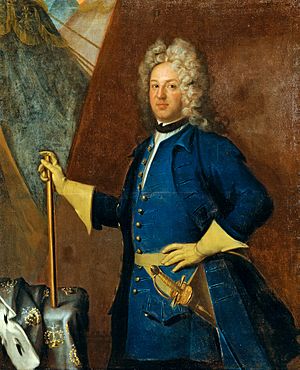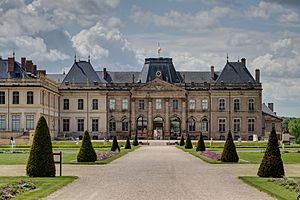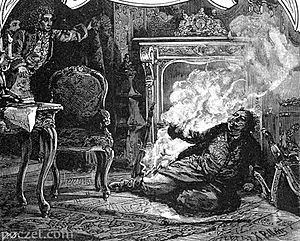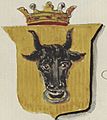Stanisław Leszczyński facts for kids
Quick facts for kids Stanisław I |
|||||
|---|---|---|---|---|---|

Portrait by David von Krafft, 1709
|
|||||
| King of Poland Grand Duke of Lithuania |
|||||
| 1st reign | 12 July 1704 – 8 July 1709 | ||||
| Coronation | 4 October 1705 | ||||
| Predecessor | Augustus II | ||||
| Successor | Augustus II | ||||
| 2nd reign | 12 September 1733 – 26 January 1736 | ||||
| Predecessor | Augustus II | ||||
| Successor | Augustus III | ||||
| Duke of Lorraine and Bar | |||||
| Reign | 9 July 1737 – 23 February 1766 | ||||
| Predecessor | Francis III Stephen | ||||
| Successor | Escheated into the Kingdom of France | ||||
| Born | 20 October 1677 Lwów, Polish–Lithuanian Commonwealth |
||||
| Died | 23 February 1766 (aged 88) Lunéville, Kingdom of France |
||||
| Burial | Wawel Cathedral, Kraków | ||||
| Spouse | Catherine Opalińska | ||||
| Issue | Anna Leszczyńska Marie, Queen of France |
||||
|
|||||
| House | Leszczyński | ||||
| Father | Rafał Leszczyński | ||||
| Mother | Anna Jabłonowska | ||||
| Religion | Roman Catholicism | ||||
| Signature | |||||
Stanisław I Leszczyński (born October 20, 1677 – died February 23, 1766) was a very important person in European history. He was the King of Poland and Grand Duke of Lithuania not once, but twice! He also held titles like Duke of Bar and Duke of Lorraine.
Stanisław's life was full of changes, especially because of big wars and political struggles in Europe. His daughter, Marie Leszczyńska, even became the Queen of France by marrying Louis XV of France. This connection to France played a huge role in his life and his attempts to rule Poland.
Early Life and Family
Stanisław was born in Lwów in 1677. His father was Rafał Leszczyński, a powerful leader in Poland. His mother was Princess Anna Jabłonowska.
He married Katarzyna Opalińska. Together, they had two daughters. One of them, Maria, grew up to marry Louis XV of France. This made her the Queen of France, which was a very important connection for Stanisław.
In 1697, Stanisław signed a document that confirmed Augustus II the Strong as the new King of Poland. Later, in 1703, he joined a group of nobles who were against King Augustus II. They had help from Sweden.
Becoming King for the First Time
The Great Northern War and Stanisław's Rise
During the Great Northern War, Sweden invaded Poland. The Swedish King, Charles XII of Sweden, wanted to remove Augustus II the Strong from the Polish throne. Charles XII chose Stanisław Leszczyński to be the new king.
Stanisław was a young man from an old, respected family. He was seen as a good choice, even though he didn't have a lot of political power on his own. With Sweden's help, Stanisław was elected King of Poland on July 12, 1704.
A few months later, Stanisław had to hide in the Swedish camp when Augustus II tried to take back the throne. But on September 24, 1705, Stanisław was crowned king with a lot of celebration. King Charles XII even gave him a new crown and scepter. Stanisław then made an alliance with Sweden against Russia.
Losing the Throne
Stanisław's power depended entirely on Sweden's success. In 1709, Charles XII of Sweden was badly defeated by Russia at the Battle of Poltava. After this, Stanisław's time as king quickly ended.
Most Poles decided to support Augustus II again. Stanisław had to leave Poland. He was given a small area called Deux-Ponts (Zweibrücken) to rule. In 1719, after Charles XII died, Stanisław moved to Wissembourg in France.
Then, in 1725, something amazing happened: his daughter Maria married Louis XV of France. This made her the Queen of France! From 1725 to 1733, Stanisław lived at the Château de Chambord in France.
Becoming King for a Second Time
The War of the Polish Succession
When Augustus II the Strong died in 1733, it sparked a new conflict called the War of the Polish Succession. Stanisław's son-in-law, Louis XV of France, supported Stanisław's claim to the Polish throne.
On September 11, 1733, Stanisław secretly traveled to Warsaw, disguised as a coachman. The next day, he was elected King of Poland for the second time. However, Russia and Austria did not want Stanisław to be king. They supported Frederick August of Saxony, the son of the late King Augustus II.
The Siege of Danzig
War broke out almost immediately. Russia sent an army to Poland. On June 30, 1734, a Russian army began to attack Stanisław and his supporters in Danzig. Stanisław was waiting for help from France.
The siege lasted for 135 days. On May 20, 1735, a French fleet arrived with 2,400 soldiers. They tried to break through the Russian defenses but had to surrender. This was the first time French and Russian armies fought each other. On June 30, 1735, Danzig surrendered.
Stanisław managed to escape two days before Danzig fell, disguised as a peasant. He went to Königsberg and tried to gather more support.
Duke of Lorraine

On January 26, 1736, Stanisław gave up the Polish throne for the second time. As a compromise, he was given the Duchy of Lorraine and the Duchy of Bar to rule. These lands would become part of France after his death.
Stanisław settled in Lunéville. He spent the rest of his life there, focusing on science and helping others. He founded the Académie de Stanislas and a public library in Nancy. He also wrote important philosophical books.
In Nancy, there is a famous square called Place Stanislas named in his honor. Much of this beautiful square was built during his time as Duke. He also discussed ideas with famous thinkers of the Age of Enlightenment, like Jean-Jacques Rousseau.
Death and Legacy
Stanisław Leszczyński died on February 23, 1766, at the age of 88. He was the longest-living Polish king. His death was tragic: his silk clothes caught fire from a spark while he was sleeping near a fireplace in his palace in Lunéville. He died from his injuries.
His titles then passed to his son-in-law, King Louis XV of France.
Stanisław was first buried in France. But after the French Revolution, his remains were brought back to Poland. He is now buried in the royal tomb at Wawel Cathedral in Kraków.
His life, especially his second attempt to become king, inspired an opera called Un giorno di regno by the famous composer Giuseppe Verdi.
Children
Stanisław and Katarzyna Opalińska had two daughters:
- Anna (1699–1717): She died young and did not marry or have children.
- Maria (1703–1768): She married Louis XV of France and became the Queen of France. They had children.
Images for kids
-
A statue of King Stanisław in Nancy, France.
-
Portrait by Jean-Baptiste van Loo, 1727–1728.
-
Portrait by Hyacinthe Rigaud.
See also
 In Spanish: Estanislao I Leszczynski para niños
In Spanish: Estanislao I Leszczynski para niños
- History of Poland (1569–1795)
- History of philosophy in Poland
- List of Poles










